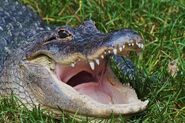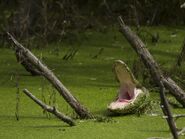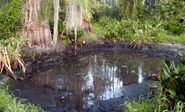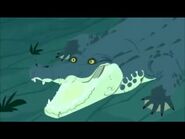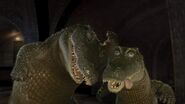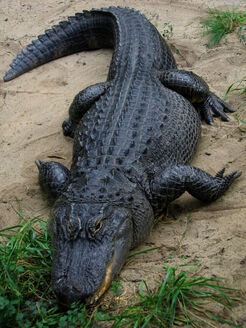
An American Alligator (One of two) in captivity at the Columbus Zoo, Columbus or Powell, Ohio.
The American Alligator (Alligator mississippiensis), sometimes referred to colloquially as a gator or common alligator, is a large crocodilian reptileendemic to the southeastern United States. It is one of two living species in the genus Alligator within the family Alligatoridae; it is larger than the other extant alligator species, the Chinese Alligator. Adult male American alligators measure up to 3.4 to 4.6 m (11 to 15 ft) in length, and can weigh up to 453 kg (999 lb). Females are smaller, measuring around 3 m (9.8 ft). The American alligator inhabits freshwater wetlands, such as marshes and cypress swamps from Texas to North Carolina. It is distinguished from the sympatric American crocodile by its broader snout, with overlapping jaws and darker coloration, and is less tolerant of saltwater but more tolerant of cooler climates than the American crocodile, which is found only in tropical climates.
Alligators are apex predators and consume fish, amphibians, reptiles, birds, and mammals. Hatchlings feed mostly on invertebrates. They play an important role as ecosystem engineers in wetland ecosystems through the creation of alligator holes, which provide both wet and dry habitats for other organisms. Throughout the year, but particularly during the breeding season, alligators bellow to declare territory and locate suitable mates. Male alligators use infrasound to attract females. Eggs are laid in a nest of vegetation, sticks, leaves, and mud in a sheltered spot in or near the water. Young are born with yellow bands around their bodies and are protected by their mother for up to one year.
The American alligator is listed as Least Concern by the International Union for Conservation of Nature. Historically, hunting had decimated their population, and the American alligator was listed as an endangered species by the Endangered Species Act of 1973. Subsequent conservation efforts have allowed their numbers to increase and the species was removed from the list in 1987. Alligators are now harvested for their skins and meat. The species is the official state reptile of three states: Florida, Louisiana, and Mississippi.
Characteristics[]
Domestic alligators vary from long and slender to short and robust, possibly due to variations in factors such as growth rate, diet, and climate. Alligators have broad snouts, especially in captive individuals. When the jaws are closed, the edges of the upper jaws cover the lower teeth which fit into the jaws' hollows. Like the spectacled caiman, this species has a bony nasal ridge, though it is less prominent. The teeth number from 74–80. Dorsally, adult alligators may be olive, brown, gray, or black in color, while their undersides are cream-colored.
Some alligators are missing an inhibited gene for melanin, which makes them albino. These alligators are extremely rare and almost impossible to find in the wild. They could only survive in captivity, as they are very vulnerable to the sun and predators.
Size[]
The American alligator is a fairly large species of crocodilian. On average it is the second largest species in the Alligatoridae family, behind only the black caiman. As with all crocodilians, and as opposed to many mammals where size eventually diminishes with old age, healthy alligators continue to expand throughout their lives and the oldest specimens are the largest. Very old, large male alligators reach an expected maximum size of up to 4.6 m (15 ft) in length, weighing up to 453 kg (999 lb), while females reach a maximum of 3 m (9.8 ft). On rare occasions, a large, old male may grow to an even greater length. During the 19th and 20th centuries, larger males reaching 5 to 6 m (16 to 20 ft) have been reported. The largest reported individual size was a male killed in 1890 on Marsh Island, Louisiana, and reportedly measured at 5.8 m (19 ft) in length, but no voucher specimen was available, since the alligator was left on a muddy bank after having been measured due to having been too massive to relocate. If the size of this animal were correct, it would have weighed approximately 1,000 kg (2,200 lb). Large adult alligators tend to be relatively robust and bulky compared to other similarly length crocodilians, for example captive males measuring 3 to 4 m (9.8 to 13.1 ft) were found to weigh 200 to 350 kg (440 to 770 lb) (although captive specimens may outweigh wild specimens due to lack of hunting behavior and other stressors). The largest alligator ever killed in Florida was 5.31 m (17.4 ft), as reported by the Everglades National Park. The largest alligator scientifically verified in Florida for the period from 1977 to 1993 was reportedly 4.23 m (13.9 ft) and weighed 473 kg (1,043 lb), although another specimen (size estimated from skull) may have measured 4.54 m (14.9 ft).
However, American alligators do not normally reach such extreme sizes. In mature males, most specimens grow up to about 3.4 m (11 ft) in length, and will weigh up to 227 kg (500 lb), while in females, the mature size is normally around 2.6 m (8.5 ft), with a body weight of up to 91 kg (201 lb). In Newnans Lake, Florida, adult males averaged 73.2 kg (161 lb) in mass and measured 2.47 m (8.1 ft) in length while adult females averaged 55.1 kg (121 lb) and measured 2.22 m (7.3 ft). In Lake Griffin State Park, Florida, adults weighed on average 57.9 kg (128 lb). Weight at sexual maturity per one study was stated as averaging 30 kg (66 lb) while adult weight was claimed as 160 kg (350 lb). While noticeably sexual dimorphic in size in very mature specimens, the sexual dimorphism of this species is relatively modest amongst crocodilians. In the saltwater crocodile, for example, the females are only slightly larger at average (2.4 m (7.9 ft) in the alligator, 2.6 m (8.5 ft) in the crocodile) than female American alligators, but the mature males, at 4.3 to 5.2 m (14 to 17 ft) on average as opposed to 2.4 to 4 m (7.9 to 13.1 ft) expected in mature male alligators, are considerably bigger than male American alligators and at median are nearly twice as long as and at least four times as heavy as the female crocodiles of the same species. Given that female alligators have relatively higher survival rates at an early age and a large percentage of given populations are comprised by immature or young breeding alligators, relatively few large mature males of the expected mature length of 3.4 m (11 ft) or more are typically seen. Weight varies considerably depending on length, age, health, season and available food sources. Similar to many other reptiles than range expansively into temperate zones, American alligators from the northern end of their range, such as southern Arkansas, Alabama, and northern North Carolina, tend to reach smaller sizes. The largest alligator caught in Alabama was 4.5 m (15 ft) in length, weighing 459 kg (1,012 lb). In Arkansas a man killed an alligator that was 4.04 m (13.3 ft) and 626 kg (1,380 lb).
Physiology[]
When on land, an alligator moves either by sprawling or walking, the latter involving the reptile lifting its belly off the ground. The sprawling of alligators and other crocodilians is not similar to that of salamanders and lizards, being similar to walking. Therefore, the two forms of territorial locomotion can be termed the "low walk" and the "high walk". Unlike most other land vertebrates, alligators increase their speed through the distal rather than proximal ends of their limbs. In the water, alligators swim like fish; moving their pelvic regions and tails from side to side. American alligators held the record as having the strongest laboratory-measured bite of any living animal, measured at up to 9,452 newtons (2,125 lbf). It should be noted that this experiment had not been, at the time of the paper published, replicated in any other crocodilians, and the same laboratory was able to measure a greater bite force in saltwater crocodiles; notwithstanding this very high biting force, the muscles opening the alligator's jaw are quite weak, and the jaws can be held closed by hand or tape when an alligator is captured. During respiration, air flow is unidirectional, looping through the lungs during inhalation and exhalation; the alligator's abdominal muscles can alter the position of the lungs within the torso, thus shifting the center of buoyancy, which allows the alligator to dive, rise, and roll within the water.
Distribution and Habitat[]
American alligators are found in the wild in the southeastern United States, from the Great Dismal Swamp in Virginia and North Carolina, south to Everglades National Park in Florida, and west to the southern tip of Texas. They are found in North Carolina, South Carolina, Georgia, Florida, Louisiana, Alabama, Mississippi, Arkansas, Oklahoma, and Texas. They inhabit swamps, streams, rivers, ponds, and lakes. Females and juveniles are also found in Carolina Bays and other seasonal wetlands. While they prefer fresh water, alligators may sometimes wander into brackish water, but are less tolerant of salt water than crocodiles, as the salt glands on their tongues do not function. One study of alligators in north-central Florida found the males preferred open lake water during the spring, while females used both swampy and open water areas. During summer, males still preferred open water, while females remained in the swamps to construct their nests and lay their eggs. Both sexes may den underneath banks or clumps of trees during the winter.
American alligators are less vulnerable to cold than American crocodiles. Unlike a crocodile, which would immediately succumb to the cold and drown in water of 45°F (7.2°C), an alligator can survive in such temperatures for some time without displaying any signs of discomfort. This adaptiveness is thought to be the reason why American alligators are widespread further north than the American crocodile. In fact, the American alligator is found farther from the equator and is more equipped to handle cooler conditions than any other crocodilian. When the water begins to freeze, alligators stick their snouts through the surface which allows them to breathe above the ice.
Ecology and Behavior[]
Alligators modify wetland habitats, most dramatically in flat areas such as the Everglades, by constructing small ponds known as alligator holes. This behavior has qualified the American alligator to be considered a keystone species. Alligator holes retain water during the dry season and provide a refuge for aquatic organisms. Aquatic organisms that survive the dry season by seeking refuge in alligator holes are a source of future populations. The construction of nests along the periphery of alligator holes, as well as a buildup of soils during the excavation process, provide drier areas for other reptiles to nest and a place for plants that are intolerant of inundation to colonize. Alligator holes are an oasis during the Everglades dry season, so are consequently important foraging sites for other organisms. In the limestone depressions of cypress swamps, alligator holes tend to be large and deep, while those in marl prairies and rocky glades are usually small and shallow, and those in peat depressions of ridge and slough wetlands are more variable.
Alligators play an important role in the restoration of the Everglades as biological indicators of restoration success. Alligators are highly sensitive to changes in the hydrology, salinity, and productivity of their ecosystems; all are factors that are expected to change with Everglades restoration. Alligators also may control the long-term vegetation dynamics in wetlands by reducing the population of small mammals, particularly coypu, which may otherwise overgraze marsh vegetation. In this way, the vital ecological service they provide may be important in reducing rates of coastal wetlandlosses in Louisiana. They may provide a protection service for water birds nesting on islands in freshwater wetlands. Alligators prevent predatory mammals from reaching island-based rookeries and in return eat spilled food and birds that fall from their nests. Wading birds appear to be attracted to areas with alligators and have been known to nest at heavily trafficked tourist attractions with large numbers of alligators, such as the St. Augustine Alligator Farm in St. Augustine, Florida. In addition to basking on shore, American alligators can and will climb trees to bask in if no shoreline is available. However, this is not often seen as the alligators will retreat back into the water by jumping from their perch.
Hunting and Diet[]
The American alligator is considered an apex predator throughout its range. They are opportunists and their diet is determined largely by both the size and age of the alligator and the size and availability of prey. Most alligators will eat a wide variety of animals, including invertebrates, fish, birds, turtles, snakes, amphibians, and mammals. Hatchlings mostly feed on invertebrates such as insects, insect larvae, snails, spiders, and worms. As they grow, alligators gradually expand to larger prey. Once an alligator reaches adulthood, any animal living in the water or coming to the water to drink is potential prey, due to the size and power of the alligator. However, most animals captured by alligators are considerably smaller than the alligator itself. Stomach contents show, among native mammals, muskrats and raccoons are some of the most commonly eaten species. In Louisiana, where introduced coypu are common, they are perhaps the most regular prey for adult alligators, although only larger adult alligators commonly eat this species. Other animals may occasionally be eaten, even large deer or feral wild boars, but these are not normally part of the diet. Occasionally, domestic animals, including dogs, cats, and calves, are taken as available, but are secondary to wild and feral prey. Other prey, including snakes, lizards, and various invertebrates, are eaten occasionally by adults. Water birds, such as herons and egrets, storks, waterfowl and large dabbling rails such as moorhens or coots, are taken when possible. Occasionally, unwary adult birds are grabbed and eaten by alligators, but most predation on bird species occur with unsteady fledgling birds in late summer as the prey of alligators, as fledgling birds attempt to make their first flights near the water's edge.
The diet of adult alligators from central Florida lakes was dominated by fish, highly opportunistically based upon local availability. In Lake Griffin, fish made up 54% of the diet by weight, with catfishbeing most commonly consumed while in Lake Apopka, fish made up 90% of the food and mostly shad were taken and in Lake Woodruff the diet was 84% fish and largely consists of bass and sunfish. Unusually in this regions, reptiles and amphibians were the most important non-piscivore prey, mostly comprised by turtles and water snakes. In southern Louisiana, crustacean (largely crayfish and crabs) were found to be present in the southeastern alligators but largely absent in the southwestern alligator which consumed a relatively high proportion of reptiles, although fish were the most recorded prey for adult alligators and adult males consumed a large portion of mammals. In East Texas, diets were diverse and adult alligators took mammals, reptiles and amphibians and invertebrates (i.e. snails) in often equal measure as they did fish.
Fish and other aquatic prey taken in the water or at the water's edge form the major part of alligator's diet and may be eaten at any time of the day or night. Adult alligators also spend considerable time hunting on land, up to 50 m (170 ft) from water, ambushing terrestrial animals on trailsides and road shoulders. Usually, terrestrial hunting occurs on nights with warm temperatures. When hunting terrestrial prey, alligators may also ambush them from the edge of the water by grabbing them and pulling the prey into the water, the preferred method of predation of larger crocodiles. The teeth of the alligator are designed to grip prey, but can not rip or chew flesh like teeth of some other predators (such as canids and felids). The alligator is capable of biting though a turtle's shell or a moderately sized mammal bone.
Vocalizations[]
Crocodilians are the most vocal of all reptiles and have a variety of different calls depending on the age, size, and sex of the animal. The American alligator can perform specific vocalizations to declare territory, signal distress, threaten competitors, and locate suitable mates. Juvenile alligators can perform a high-pitched hatchling call (a "yelping" trait common to many crocodilian species' hatchling young) to alert their mothers when they are ready to emerge from the nest. Juveniles also make a distress call to alert their mothers if they are being threatened. Although alligators have vocal cords, they function differently than mammals. Both males and females bellow loudly to attract mates and declare territory by sucking air into their lungs and blowing it out in intermittent, deep-toned roars. The bellowing of the American alligator is distinct from the loud roaring of most crocodilians, and is considered unique. Male alligators are known to use infrasound during mating bellows. Bellowing is performed in a "head oblique, tail arched" posture. Infrasonic waves from a bellowing male alligator can cause the surface of the water directly over and to either side of its back to literally "sprinkle" in what is commonly called the "water dance". Large bellowing "choruses" of alligators during the breeding season are commonly initiated by females and perpetuated by males. Observers of large bellowing choruses have noted they are often felt more than they are heard due to the intense infrasound emitted by males. Alligators bellow in B flat, and bellowing choruses can be induced by tuba players, sonic booms, and large aircraft. In addition to bellowing, alligators can growl, hiss, or cough to threaten others and declare territory.
Reproduction[]

Nest and young in Florida
The breeding season begins in the spring. On spring nights, alligators gather in large numbers for group courtship, in the aforementioned "alligator dances". The female builds a nest of vegetation, sticks, leaves, and mud in a sheltered spot in or near the water. After she lays her 20 to 50 white eggs, about the size of a goose egg, she covers them with more vegetation, which heats as it decays, helping to keep the eggs warm. This differs from Nile crocodiles, which lay their eggs in pits.
The temperature at which alligator eggs develop determines their sex (see temperature-dependent sex determination). Those eggs which are hatched at a temperature of 34 °C (93 °F) or more become males, while those at a temperature of 30 °C (86 °F) or lower become female. The nests built on levees are warmer and thus produce males, while the cooler nests of wet marsh produce females. The female remains near the nest throughout the 65-day incubation period, protecting it from intruders. When the young begin to hatch — their "yelping" calls can sometimes even be heard just before hatching commences — the mother quickly digs them out and carries them to the water in her mouth, as some other crocodilian species are known to do.
The young are tiny replicas of adult alligators with a series of yellow bands around their bodies that serve as camouflage. Hatchlings gather into pods and are guarded by their mother and keep in contact with her through their "yelping" vocalizations. Young alligators eat small fish, frogs, crayfish, and insects. They are preyed on by large fish, birds, raccoons, and adult alligators. Mother alligators eventually become more aggressive towards their young, which encourages them to disperse. Young alligators grow 3–8 in (7.6–20.3 cm) a year and reach adulthood at 6 ft (1.8 m). An alligator can live up to 50 years.
